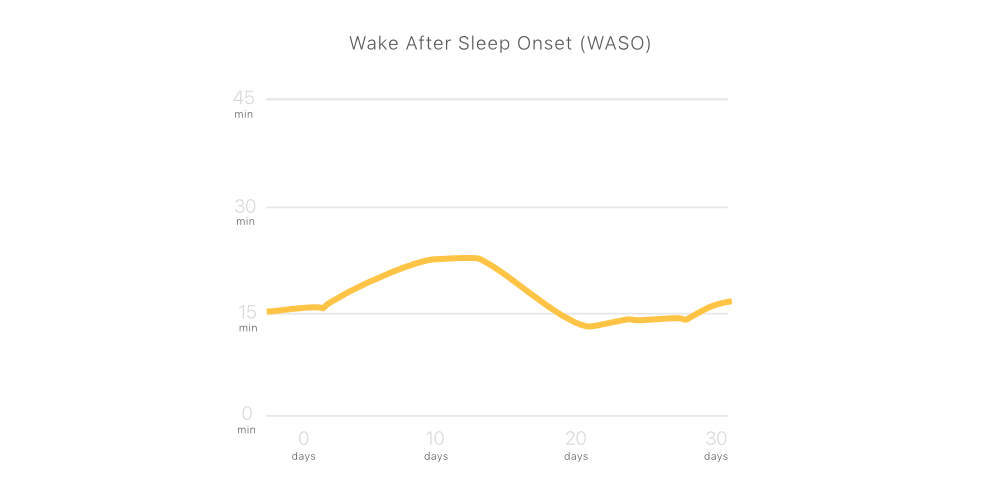
Sleep is cool again. Sleep doctors all over the world are reporting an increase in people wanting to undergo sleep tests or for professional interpretation of sleep data from health trackers. Instead of going through the more common sleep metrics that people obtain from their health trackers such as total sleep time, deep sleep and REM sleep, in this article I want to focus on an underrated sleep metric that can tell us a lot about the quality of our sleep. This metric is wake time after sleep onset or WASO.
WASO is a measure of the amount of time an individual spends awake after they have fallen asleep and before they fully wake up. It is usually measured in minutes and is one of the metrics measured during sleep studies such as polysomnography. It is calculated using the following formula:
WASO = time in bed - total sleep time - sleep onset latency
Time in bed: the total duration of time spent in bed from light out to lights on.
Total sleep time: The time from falling asleep to being fully awake at the end of sleep.
Sleep onset latency: the time it takes after getting into bed to go from being fully awake to falling asleep.
Health trackers such as Whoop and Oura have been shown in studies to be accurate when compared to medical grade sleep studies in determining duration of wakefulness. I wrote more about the accuracy of these devices in measuring sleep metrics here. The only issue is that some devices don’t show WASO as a separate metric on their dashboards. This is why Span uses raw data from wearables to display custom metrics such as WASO for each individual.
We sleep in cycles of approximately 90 minutes throughout the night. A stage of sleep called REM sleep happens towards the end of each cycle and is characterised by a total paralysis of the body. At the end of this stage it is normal to wake up briefly and change position. You might not remember this when you wake up in the morning because you are not usually fully awake at the time. These brief awakenings can accumulate over the course of the night but should ideally not sum up to more than 30 minutes. A significantly high WASO can be seen in people with sleep disorders such as sleep apnea, insomnia or restless leg syndrome.
The 30 minute mark is a general rule of thumb but normal WASO can vary over the course of a lifetime. In younger persons in their twenties for example, WASO usually constitutes less than 5% of total sleep time. In older people this can go up to 15%. That being said, a lower WASO is usually indicative of better sleep quality.

If your WASO is significantly increased, the first thing you should do is consult a sleep specialist to make sure you don’t have a sleeping disorder or any other condition that can affect sleep quality. Cognitive behavioural therapy for insomnia is a very effective tool and can have tremendous benefits on WASO in these individuals. That being said, there are some easy to implement interventions that have been shown to improve WASO. Please consult your sleep specialist to see if these are appropriate for you.
First, start with the basics. Make sure that your bedroom is as dark as possible throughout the night and early morning. Light can signal to your body that it is time to wake up and it may make it difficult to go back to sleep once you’ve “seen the light”. Another important point is to ensure silence throughout the night. This is another basic sleep hygiene technique that is neglected by some. If you do not have much control over your sleep environment you may want to consider comfortable ear plugs to block out any noise.
Temperature regulation has been shown to improve sleep quality and reduce WASO. Although this is highly variable between different people. There is no “optimal temperature” that works for everyone. This is why at Span we guide and encourage experimentation with different sleep temperature regulation techniques that can help people find the optimal temperature for them. It may even vary by body part!. Some people have reported better WASO with cooler (or sometimes warmer) feet or hands during the night. We naturally use our feet and hands as a temperature control organ at sleep. This is why we sometimes naturally stick a foot out when sleeping, our bodies use it to lose heat and lower our core body temperature.
A common cause of waking up at night with difficulty getting back to sleep is the disruption of the natural sleep-wake cycle called the circadian rhythm. This can result in lower levels of melatonin during the night which is a hormone that is naturally secreted during the night and helps us fall and stay asleep. Apart from resetting the circadian rhythm with better sleep hygiene, using melatonin supplements can work for some people. We wrote more about using melatonin here. Some foods such as cherries contain melatonin and can help with some people.
Another cause of sleep disruption at night is waking to urinate. This is a common cause in the elderly and in certain medical conditions but is common with young and healthy individuals too. This can be caused by increased fluid intake in the hours preceding sleep. I plan to write more about this in more detail in a separate article, but if you frequently wake up to urinate at night, you may want to consider reducing fluid intake before going to bed.
If you find yourself awake for a period of more than 20 minutes at night, consider getting out of bed all together and spend some time elsewhere until you feel sleepy again. The idea here is to maintain the mental association of bed with sleep and nothing else.
Another technique that can help fall back to sleep is PMR or progressive muscle relaxation. It is a simple technique which can help us fall back to sleep faster and block out excessive thoughts that keep us awake. The technique is done by gradually relaxing all the muscles of the body starting with one area (such as your face and head) and then moving on to another part of the body until the whole body is covered.
Finally, it is important not to put too much focus on any one metric without the right context. Always correlate your sleep metrics with how you feel and look at trends over time instead of one off numbers.
How to interpret the results of a sleep study
https://www.ncbi.nlm.nih.gov/pmc/articles/PMC4246141/
Cognitive Behavioral Therapy for Chronic Insomnia: A Systematic Review and Meta-analysis
https://pubmed.ncbi.nlm.nih.gov/26054060/
Principles and Practice of Sleep Medicine, Kryger, MH et al., Elsevier, 6th edition, 2017
https://www.sciencedirect.com/book/9780323242882/principles-and-practice-of-sleep-medicine
National Sleep Research Resource
https://sleepdata.org/